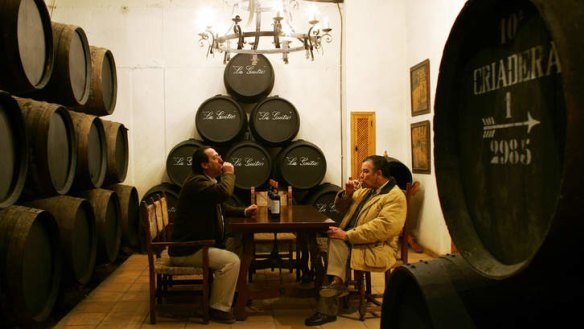All the time in the world
In Spain's south, air, soil and ageing create a dry sherry with a true taste of the sea.

It's mid-afternoon and Sanlucar de Barrameda's warm sea-breeze starts to drift through Plaza Cabildo, the square famous for its tapas bars or tabancos where sherry is poured straight from barrel. The seafood in this Spanish region is equally lauded. Naturally, the complimentary drink of choice is the dry, refreshing and extraordinary manzanilla, an agile fortified wine.
Sanlucar is also near two other great sherry regions, the famous Jerez de la Frontera and El Puerto de Santa Maria. All produce sherry, one of the world's most underrated wine styles.
Yet the bone-dry, spine-tingling fresh, sea-salty, camomile-nuanced and utterly exhilarating sherry known as manzanilla can only come from this area. In Jerez and El Puerto, the sibling is fino, which is also deliciously dry but, by law, not manzanilla. That belongs to Sanlucar. There are subtle differences between them.
So what makes manzanilla unique?
''It is important to understand the micro-climate is different to Jerez,'' says Jorge Pascual Hernandez, president of Delgado Zuleta, one of the top sherry producers in Sanlucar. ''That wind is the very fresh westerly poniente making the region about three to four degrees cooler than Jerez, and it has a higher humidity, around 80 per cent.''
And how to explain the sea-salty character that infiltrates manzanilla in particular? Smell the poniente. It wafts into the humid bodegas where row upon row of barrels of sherry age.
Sanlucar sits at the mouth of the Guadalquivir river, an Arabic word meaning ''great river''. And it is. Starting in the Carzoria mountain range, its 657-kilometre journey ends here flowing into the Atlantic Ocean from the Gulf of Cadiz. That river, that ocean plays a crucial part in the making of manzanilla.
''Then, there are the soils. There are three types but the most important is the albariza, mostly found at the top of hills and it's very chalky and it acts like a sponge because it retains water that helps the vines during the dry summer spell,'' Hernandez says. ''And of course the grapes are important.''
Dry sherries are made from palomino that he likens to riesling. ''We are not looking for special flavour from the grape but noble material for ageing. We are looking for body, for personality, it's a variety that isn't very expressive. Sherry is a question of time. It takes time to make the best wine.''
At two years of age, manzanilla, and fino, can be bottled but the most complex examples are aged for much longer. And yet they stay fresh thanks to an utterly amazing natural process - flor, a layer of yeast that sits atop of the wine while in barrel, a layer of protection from oxygen. Flor is the unique element in defining the style and taste of sherry.
During a two-hour tabanco crawl with Herandez, he also talks about the region's rich history, the melding of cultures over hundreds of years that have influenced the making of sherry, the British predilection for sweet sherries partly adding to the confusion over styles and how, in the 1990s the region sold 120 million litres of sherry whereas today it sits at 40 million litres. However, sherry is definitely not moribund.
Some drops of manzanilla
Herederos De Argueso San Leon Clasica Manzanilla, 375ml, $17
The San Leon Clasica will enliven any dulled palate because it's super-fresh, tangy, sea salty and complex with a hint of dried herbs. Argueso also produces an outstanding Reserva de la Familia $27 - a manzanilla pasada, meaning aged, which, in this case, is about 10 years. It is one of the finest; amber-hued, complex, nutty with a rich palate yet dry and long on the finish.
Delgado Zuleta Goya Xl Manzanilla En Rama, 500ml, $62
While locals in Sanlucar de Barrameda demand their manzanilla looks crystal clear and shiny bright otherwise they won't drink it, en rama is the sherry for aficionados who know its amber colour means it has been lightly clarified. Meaning ''raw'', en rama is like tasting the wine straight out of barrel. Of course, the complexity also comes from the fact Goya XL is about 10 years old. Beautifully balanced, strong and full of flavour with hints of camomile and brine-tempered with savoury nutty notes. A truly stunning sherry.
Sanchez Romate Palo Cortado Regente, $58
In a sense, true palo cortado makes itself. It has a fuller body and that means it's not destined to be fino. The cellar master will refortify the wine to kill any remaining flor and allow the wine to morph into palo cortado. Regente from Sanchez Romate is a 30-year-old sherry of great depth and complexity. It's very aromatic, nutty, round and luscious yet long and dry on the finish.
World Sherry Day
For several years, Melbourne's MoVida and Bar Lourinha have led the charge by offering a selection of great sherries that match brilliantly with their dishes.
And now, German-born Sweden-based Wolfgang Hess, a certified sherry educator and former chef, has kick-started the inaugural celebration devoted to the wine: World Sherry Day on May 26. It's an initiative where anyone wanting to host a sherry event simply needs to organise one then register it online. MoVida Next Door is hosting Melbourne's event.
''I'm positive about the future of sherry. It'll never be about volume again but it will be, must be about quality,'' Jorge Pascual Hernandez says. ''Things are changing and even a few years ago, who would have thought Australians were [dry] sherry drinkers?''
For information about MoVida Next Door's event for World Sherry Day May 26, see movida.com.au. Tickets cost $70 for tapas matched to six different sherries.